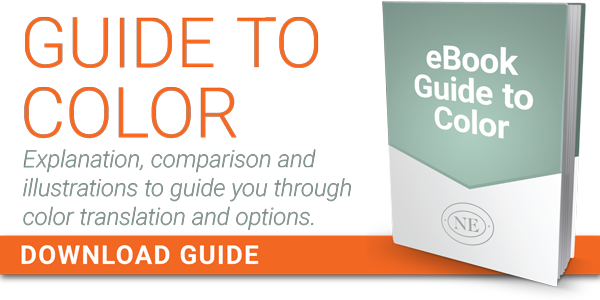Changing Color and Gloss Effects on Aluminum Trim
Changing Color and Gloss Effects
It's been said many times in posts related to options for customization in patterns and finishes for aluminum nameplates and trim. Color, gloss, or scale - any of these can be tweaked to work with your design. Color can be defined with a master or target chip. A common reference for color is the Pantone Matching System (PMS). Gloss is a measurement of the amount of light reflected off a surface and can be developed into low, medium and high percentages. Here are some examples showing the same pattern scale and what happens when color or gloss is changed.
Color
PAT-4837-A is developed as a silver finish coupled with halftones and selective brushed aluminum for a dimensional structure and a sporty look.
PAT-4837-B keeps the structure created with halftones and selective brushed aluminum but changes to a darker black tint for a more classic look.
Gloss
PAT-4837-B uses an overall low gloss which softens the look, helping the dimension to be subtle and understated.
PAT-4837-C takes the same black tint and dimensional structure but uses an overall high gloss. This creates a laquer-like shininess for a more dramatic and high energy look. Additionally the black tint appears darker.
Pulling it Together
Changing the color or gloss level allows you to update the look of your product for little to no change in price because the structure has been defined and accounted for with the preparations. The difference can be as subtle as a move left or right on the color spectrum. Or as deliberate as defining one product to have a soft matte black look and another to show a highly polished candy apple red.
What other questions about finish development do you have? Feel free to share in the comments below.
Subscribe to Design Blog
- 2021 (1)
- 3D (5)
- Aluminum (88)
- Aluminum In-mold (3)
- Aluminum Trim (87)
- Anodize (2)
- Appliance (5)
- Architectural (9)
- Art Deco (4)
- Automotive (15)
- Black Finish (2)
- Boats (1)
- Brushed Aluminum (25)
- Carbon Fiber (11)
- Ceiling Tile (3)
- Classic (2)
- Coating (1)
- Coined (3)
- Color Development (2)
- Color Trend (2)
- Copper Finish (2)
- Cosmetics (2)
- Custom Patterns (49)
- Customization (7)
- Customized Patterns on Aluminum (2)
- Decorated Metal Cards (1)
- Diamond Cut (2)
- ebook (8)
- Faux Finishes (20)
- Favorite Finish (19)
- Fine Art (5)
- geometric (1)
- Geometric Finish (8)
- Gloss (3)
- Gold Finish (2)
- gray (4)
- Holiday Card (3)
- IDSA (3)
- Inlay (4)
- Large Format (3)
- linear (2)
- Linear Finish (6)
- Lithography (2)
- Match Box Cover (4)
- Materials and Processes (29)
- Mechanical Finishes (37)
- Metallic (2)
- Micro Finish (4)
- Modern (2)
- Mood Board (30)
- Nameplate (3)
- NeoCon (1)
- Organic Finish (2)
- Organic Finishes (13)
- Patina Finish (12)
- Pattern on Pattern (1)
- Powerful (2)
- Process Color (6)
- Promotional Products (13)
- Recycled Aluminum (3)
- Resources (12)
- Selective Patterns (9)
- Silver Finish (7)
- Simplicity (2)
- Stainless Steel (3)
- Surface Collection (32)
- Surfaces (87)
- Technical (11)
- Texture (15)
- Top 10 (9)
- Top 3 (1)
- Watermark (2)
- White Finish (3)
- Woodgrain (7)
- Worn (3)
- Woven Finish (6)





